维多利亚时代【英文】
- 格式:ppt
- 大小:9.56 MB
- 文档页数:18

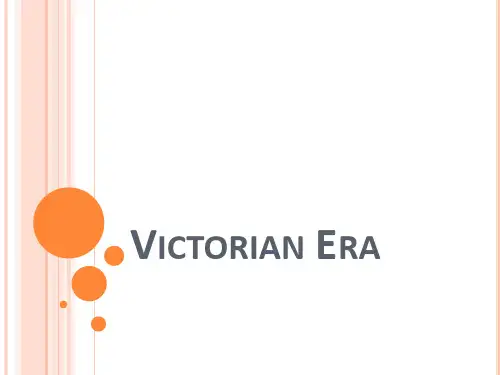
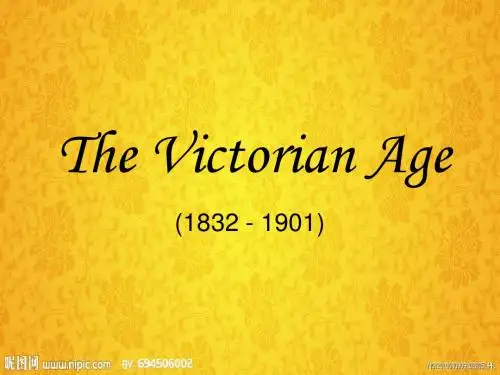
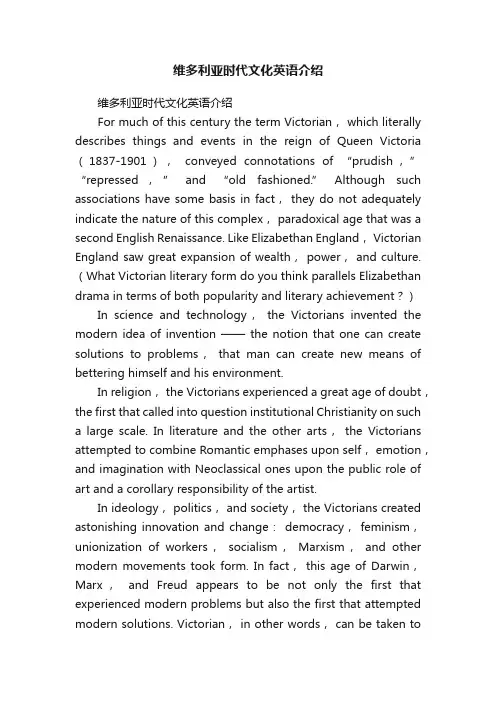
维多利亚时代文化英语介绍维多利亚时代文化英语介绍For much of this century the term Victorian, which literally describes things and events in the reign of Queen Victoria (1837-1901),conveyed connotations of “prudish,” “repressed,” and “old fashioned.” Although such associations have some basis in fact, they do not adequately indicate the nature of this complex, paradoxical age that was a second English Renaissance. Like Elizabethan England, Victorian England saw great expansion of wealth, power, and culture. (What Victorian literary form do you think parallels Elizabethan drama in terms of both popularity and literary achievement?)In science and technology,the Victorians invented the modern idea of invention ——the notion that one can create solutions to problems,that man can create new means of bettering himself and his environment.In religion, the Victorians experienced a great age of doubt,the first that called into question institutional Christianity on such a large scale. In literature and the other arts,the Victorians attempted to combine Romantic emphases upon self, emotion,and imagination with Neoclassical ones upon the public role of art and a corollary responsibility of the artist.In ideology, politics, and society, the Victorians created astonishing innovation and change:democracy,feminism,unionization of workers,socialism,Marxism,and other modern movements took form. In fact,this age of Darwin,Marx,and Freud appears to be not only the first that experienced modern problems but also the first that attempted modern solutions. Victorian, in other words, can be taken tomean parent of the modern —— and like most powerful parents,it provoked a powerful reaction against itself.The Victorian age was not one,not single,simple,or unified, only in part because Victoria's reign lasted so long that it comprised several periods. Above all, it was an age of paradox and power. The Catholicism of the Oxford Movement,the Evangelical movement, the spread of the Broad Church, and the rise of Utilitarianism, socialism, Darwinism, and scientific Agnosticism,were all in their own ways characteristically Victorian; as were the prophetic writings of Carlyle and Ruskin,the criticism of Arnold, and the empirical prose of Darwin and Huxley;as were the fantasy of George MacDonald and the realism of George Eliot and George Bernard Shaw.More than anything else what makes Victorians Victorian is their sense of social responsibility, a basic attitude that obviously differentiates them from their immediate predecessors,the Romantics. T ennyson might go to Spain to help the insurgents, as Byron had gone to Greece and Wordsworth to France;but Tennyson also urged the necessity of educating “the poor man before making him our master.” Matthew Arnold might say at mid-century thatthe world,which seems T o lie before us like a land of dreams,So various, so beautiful, so new,Hath really neither joy, nor love, nor light,Nor certitude, nor peace, nor help for pain.but he refused to reprint his poem “Empedocles on Etna,” in which the Greek philosopher throws himself into the volcano,because it set a bad example;and he criticized an Anglican bishop who pointed out mathematical inconsistencies in the Bible not on the grounds that he was wrong,but that for abishop to point these things out to the general public was irresponsible.。


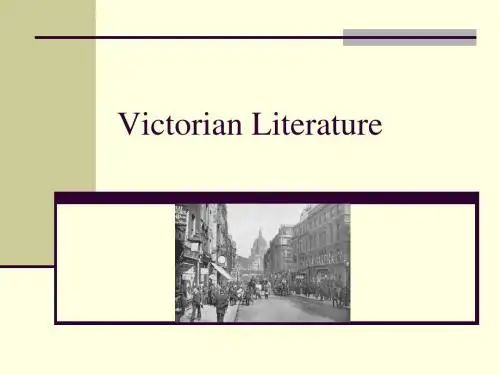
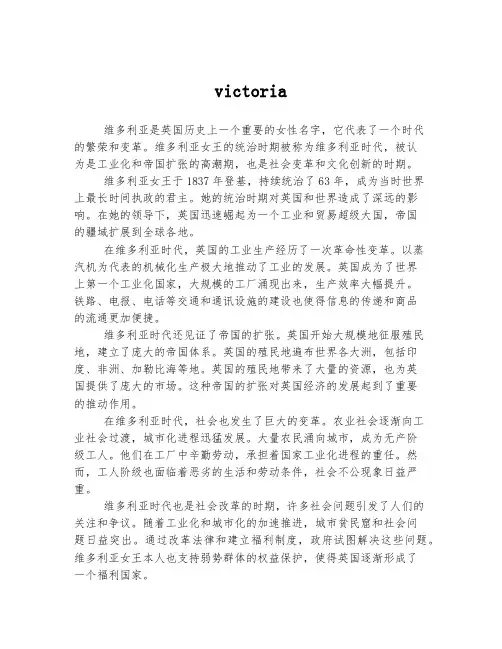
victoria维多利亚是英国历史上一个重要的女性名字,它代表了一个时代的繁荣和变革。
维多利亚女王的统治时期被称为维多利亚时代,被认为是工业化和帝国扩张的高潮期,也是社会变革和文化创新的时期。
维多利亚女王于1837年登基,持续统治了63年,成为当时世界上最长时间执政的君主。
她的统治时期对英国和世界造成了深远的影响。
在她的领导下,英国迅速崛起为一个工业和贸易超级大国,帝国的疆域扩展到全球各地。
在维多利亚时代,英国的工业生产经历了一次革命性变革。
以蒸汽机为代表的机械化生产极大地推动了工业的发展。
英国成为了世界上第一个工业化国家,大规模的工厂涌现出来,生产效率大幅提升。
铁路、电报、电话等交通和通讯设施的建设也使得信息的传递和商品的流通更加便捷。
维多利亚时代还见证了帝国的扩张。
英国开始大规模地征服殖民地,建立了庞大的帝国体系。
英国的殖民地遍布世界各大洲,包括印度、非洲、加勒比海等地。
英国的殖民地带来了大量的资源,也为英国提供了庞大的市场。
这种帝国的扩张对英国经济的发展起到了重要的推动作用。
在维多利亚时代,社会也发生了巨大的变革。
农业社会逐渐向工业社会过渡,城市化进程迅猛发展。
大量农民涌向城市,成为无产阶级工人。
他们在工厂中辛勤劳动,承担着国家工业化进程的重任。
然而,工人阶级也面临着恶劣的生活和劳动条件,社会不公现象日益严重。
维多利亚时代也是社会改革的时期,许多社会问题引发了人们的关注和争议。
随着工业化和城市化的加速推进,城市贫民窟和社会问题日益突出。
通过改革法律和建立福利制度,政府试图解决这些问题。
维多利亚女王本人也支持弱势群体的权益保护,使得英国逐渐形成了一个福利国家。
在文化领域,维多利亚时代也是一段充满创新和探索的时期。
文学、艺术、建筑等领域出现了许多杰出的作品和人物。
查尔斯·狄更斯、奥斯卡·王尔德、塞缪尔·巴克斯特等作家的作品广受欢迎,成为经典的代表作。
建筑风格也发生了变化,维多利亚式建筑成为了当时的主流风格。
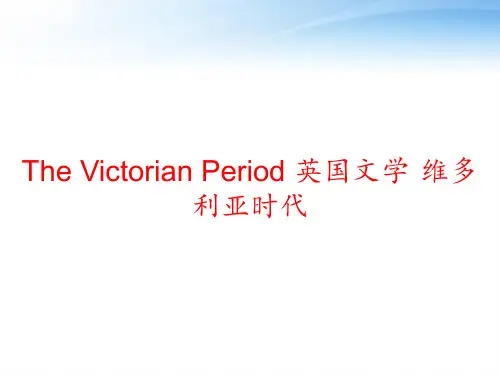
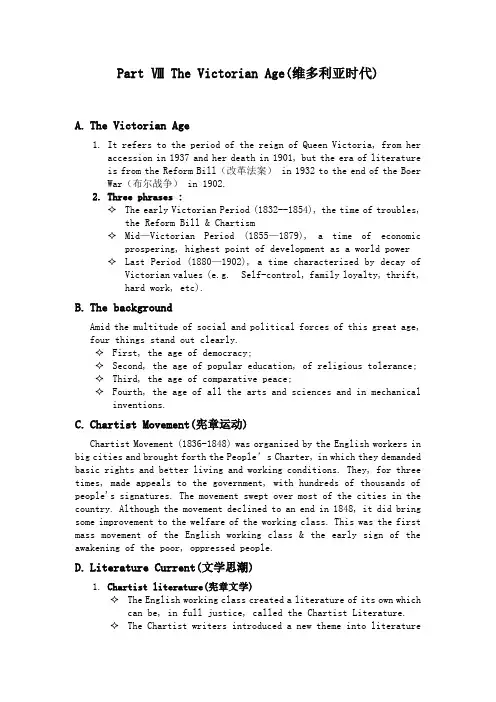
Part Ⅷ The Victorian Age(维多利亚时代)A.The Victorian Age1.It refers to the period of the reign of Queen Victoria, from heraccession in 1937 and her death in 1901, but the era of literature is from the Reform Bill(改革法案) in 1932 to the end of the Boer War(布尔战争) in 1902.2.Three phrases :✧The early Victorian Period (1832--1854), the time of troubles,the Reform Bill & Chartism✧Mid—Victorian Period (1855—1879), a time of economicprospering, highest point of development as a world power✧Last Period (1880—1902), a time characterized by decay ofVictorian values (e.g. Self-control, family loyalty, thrift,hard work, etc).B.The backgroundAmid the multitude of social and political forces of this great age, four things stand out clearly.✧First, the age of democracy;✧Second, the age of popular education, of religious tolerance;✧Third, the age of comparative peace;✧Fourth, the age of all the arts and sciences and in mechanicalinventions.C.Chartist Movement(宪章运动)Chartist Movement (1836-1848) was organized by the English workers in big cities and brought forth the People’s Charter, in which they demanded basic rights and better living and working conditions. They, for three times, made appeals to the government, with hundreds of thousands of people's signatures. The movement swept over most of the cities in the country. Although the movement declined to an end in 1848, it did bring some improvement to the welfare of the working class. This was the first mass movement of the English working class & the early sign of the awakening of the poor, oppressed people.D.Literature Current(文学思潮)1.Chartist literature(宪章文学)✧The English working class created a literature of its own whichcan be, in full justice, called the Chartist Literature.✧The Chartist writers introduced a new theme into literature— the struggle of the proletariat(无产阶级) for its rights.✧Some great Chartist poets are Ernest Jones (1819-1869), ThomasCooper (1805-1892), and William James Linton (1812-1897).2.Critical Realism(批判现实主义文学)✧Critical Realism is one of the literary genres that mainlyflourished in the 40s and in the early 50s in the 19th century.The critical realists not only gave the criticism tobourgeoisie and all ruling classes, bur also showed their deepsympathy for the common people. Hence humor and satire aboundin the English realistic novels of the 19th century. But thecritical realists did not find a way to eradicate(根除) socialevils. They did not realize the necessity of changing thebourgeois society. They were unable to find a good solutionto the social contradictions. The chief tendency in their worksis not of revolution but rather of reformism. Here we see atonce the strength and the weakness of critical realism. Threegreatest representatives of Critical Realism are CharlesDickens(狄更斯), William Makepeace Thackeray(萨克雷), andGeorge Eliot(艾略特). E.………………………………………………………………………………………………. F.…………………………………………………………………………………………………G.………………………………………………………………………………………………….H.Some Exercises1.The precisian may limit the Victorian period to the years betweenthe Queen’s accession in 1837 and her death in 1901, but a newera really began with the passage of the Reform Bill in 1832 andclosed at the end of the Bore war in 1902.2.Victorian literature, as a product of its age, naturally took onits quality of magnitude and diversity. It was many-sacked andcomplex, and reflected both romantically and realistically thegreat changes that were going on in people’s life and thought.3.In the 19th century English literature, a new literary trendcritical realism appeared after the romantic poetry, andflourished in the 40s and in the early 50s.4.Critical realism found its expression in the form of novel; mostof the critical realists were novelists.5.Critical realism reveals the corrupting influence of the rule ofcash upon human nature. Here lies in the essentially democraticand humanistic character if critical realism.6.The Chartist Movement appeared in the 30s of the 19th century.7.The most important poet of the Victorian Age was Tennyson, nextto him, were Robert Browning and his wife.8.The Chartist writers introduced a new theme into literature: thestruggle of the proletariat for its rights.9.The Chartist poetry played an important role in the developmentof English proletariat literature; the greatest Chartist poet was Ernest Jones. I..............................................................................J.Charles Dickens(狄更斯)A.LifeCharles Dickens (1812--1870) was born in a poor family in the Portsmouth. He gave up schooling to work after his father was put into the prison because of the debt. In 1870, he died of overwork.B.The three period of his literary career1.the first period of youthful optimismAt this stage Dickens believed that all the evils of the capitalist world would be remedied if only men behaved to each other with kindliness, justice, and sympathetic understanding.Main works in this period:Sketches by Boz 《博兹随笔》Pickwick Paper 《匹克威克外传》Oliver Twist 《雾都孤儿》Nicholas Nickleby 《尼古拉斯尼克贝》Old Curiosity Shop 《老古玩店》Barnaby Rudge 《巴纳比卢杰》2.the second period of excitement & irritationDickens' second period began from 1842, the year after his first visit to America.Main works in this period:American Notes 《美国札记》Martin Chuzzlewit 《马丁朱杰尔维特》A Christmas Carol 《圣诞欢歌》The Chimes 《钟声》The Cricket on the Hearth 《炉边蟋蟀》Dombey and Son 《董贝父子》David Copperfield 《大卫科波菲尔》3.the third period of steadily intensifying pessimismThe last period of Dickens's literary career began with the publication of "Bleak House" in 1852-1853.Up to this time Dickens maintained some hope of reform under capitalism but beginning from "Bleak House" there was an "underlying tone of bitterness" which showed the novelist's loss of hope for English bourgeois society.Main works in this period:Bleak House《荒凉山庄》Hard Time《艰难时世》Little Dorrit《小杜丽》A Tale of Two Cites《双城记》Great Expectations 《远大前程》Our Mutual Friend 《我们共同的朋友》Edwin Drood(unfinished) 《埃德温多鲁德》C.Distinct Features of His Novels(1) Character Sketches & Exaggeration(2) Broad Humor & Penetrating Satire(3) Complicated & Fascinating Plot(4) The Power of Exposurements of DickensCharles Dickens is one of the greatest critical realistic writers of the Victorian Age.In his works, Dickens sets a full map & a large-scale criticism of the 19th-century England, particularly London..Characterization is the most outstanding feature of his works.Dickens also employs exaggeration in his works.Yet he is a petty bourgeois intellectual. He could not overstep the limits of his class. He failed to see the necessity of a bitter struggle of the oppressed against their oppressors.E.Some works1.The Pickwick Papers《匹克威克外传》Plot2.Oliver Twist 《雾都孤儿》PlotThe novel tells the story of a poor child named Oliver Twist. He is born in a workhouse and brought up under miserable conditions.After experiencing an unhappy apprenticeship to an undertaker, he runs away to London, where he falls into the hands of a gang of thieves.Then he is made to be a pickpocket. A benevolent rich old man called Mr. Brownlow rescues him and takes him home, but the thieves kidnap him and make him join them once again. A bad person named Monks, who turns out to be Oliver’s half-brother, helps the thieves in keeping Oliver in the gang, in order to ruin him and obtain the whole of his father’s property. Then Oliver i s made to help one the thieves in breaking into a lady’s house. He gets wounded, and comes into the hands of her aunt. Finally the thieves in the gang are punished and Oliver’s half brother is compelled to confess his evil doing and put into prison. Oliver is adopted by Mr. Brownlow.F.Some exercises1. Charles Dickens was the greatest representative of English Critical Realism.2. Of all of Dickens’s novels, David Copperfield is regarded as his masterpiece.3. In A Tale of Two Cities, the two cities are London and Paris in the time of revolution.4. The novel Nicholas Nickleby touches upon a burning question of Dickens’s time; the education of children in the private schools.5. The novel Oliver Twist tells the story of a poor child named Oliver Twist who was born in a workhouse and brought up under miserable conditions.6. The novel Hard Times makes a fierce attack on the bourgeois systemof education and the bourgeois philosophy Utilitarianism.G.OthersWilliam Makepeace Thackeray(萨克雷)A.His worksThe Books of Snobs 《势力人》Vanity Fair《名利场》Pendennis 《潘丹尼斯的历史》The Newcomers《纽卡母一家》The Rose and the Ring (fairy tale) 《玫瑰与戒指》(通话)Henry Esmond《亨利·艾斯芒德》The Virginians (historical novels) 《弗吉尼亚人》B.Characteristics of Thackeray’s novels1.William Makepeace Thackeray is one of the greatest critical realists of the 19th century.The pictures in his novels are accurate and true to life. He is good at describing the life of the upper class with which he is familiar.2.Thackeray is a satirist.3.He is a moralist. His aim is to produce a moral impression in all his novels.C.Vanity Fair《名利场》1.The Origin of the TitleThis title was borrowed by Thackeray from The Pilgrim’sProgress (天路历程) by Bunyan. It means “a fair, wherein aresold all sorts of vanity.”2.The Implication of the Subtitle----Novel Without a Hero✧No exactly positive character✧About women instead of men✧Not about some particular person but about the society3.Theme of the novelIn this novel Thackeray describes the life of the upper class of England in the early decade of the 19th century, and attacks the social relationship of the bourgeois world by satirizing the individual in the different strata of the upper society. It is a world where money grubbing is the main motive for all members of the upper class.4. Characters: A brief comment on Amelia and Becky in Vanity Fair In Vanity Fair Thackeray successfully characterizes two heroines who stand in contrast in their characters and attitudes towards life.Amelia is a character of milk-and-water type, good in nature, tame and moral, sentimental and sympathetic, but unable to master her own fate. Becky, who is more impressively character and can be said to be the real heroine of the novel in a way, is different from Amelia;she is crafty, unscrupulous, and resourceful and she is neverobedient to her destiny and always rebels in order to have a change in her life, regardless of morality and the social judgment of her.The two heroines are, to Thackeray, the victims of the social environment that is inhuman in its nature.5.D.Some exercise1.In 1847, Thackeray published his masterpiece Vanity Fair, whichmarks the peak of his literary career.2.The sub-title of Vanity Fair is Novel without a Hero. The writer’sintention was not to portray individuals, but bourgeois and aristocratic society as a whole.3.The main plot of Vanity Fair renders on the story of two women:Amelia Sedlley and Rebecca Sharp, whose characters are sharp contrast.E.othersGeorge Eliot(爱略特)----Pseudonym of Mary Ann Evans.A.Her Works✧Scenes of Clerical Life 《教区生活场景》✧Adam Bede《亚当贝德》✧Mill on the Floss《弗洛斯河上的磨坊》✧Silas Marner《织工马南》✧Middlemarch《米德尔马奇》✧需要补充B.Some exercises1.George Eliot was the Pseudonym of Mary Ann Evans.2.The author of The Mill on the Floss is George Eliot.3.George Eliot produced three remarkable novels including Adam Bede,The Mill on the Floss and Silas Marner.4.In the novel Adam Bede, Adam falls in love with a village girl calledHetty Sorrel who is seduced and deserted by a squire.C.OthersCharlotte Bronte and Emily Bronte(夏洛特和爱米丽)A.Works of Bronte Sisters✧Charlotte Bronte Professor《教授》Jane Eyre《简·爱》Shirley《雪丽》Villette.《维莱特》✧Emily Bronte Wuthering House《呼啸山庄》✧Ann Bronte Agnes Grey 《安格尼斯·格雷》The Tenant of Wildfell Hall《维尔德·霍的佃户》B.Jane Eyre1.The theme of the novel✧The criticism of the bourgeois system of education✧The position of the women in society ---- the women should theequal rights with men2.The limitation of the novelCharlotte believes that education is the key to all social problems, and that by the improvements of the school system, mostof the social evils could be removed.3.Why the novel is greatly admired?1) Jane’s characteristics.2) Jane’s treatment of her love and marriage.Jane, differentfrom many other women in the mammon worship society, considersmarriage not as a bargain but as a union of kindred souls.3) Jane sticks to her principles, successfully resists theoppression and other social evils in the inhuman world andacquires her own happiness.4) It contains the author’s criticism of bourgeois attitudetoward marriage and love, and her ruthless expose of inhumanmisery in charity schools of her days which were establishedand run in the name of philanthropy. She attacks the terribleeducational system in her day and points out the miserable fateof poor girls as charity school pupils and as governess.4.C.Wuthering HouseD.Some exercises1.The Bronte sisters are Charlotte Bronte, Emily Bronte and AnnBronte.2.Charlotte Bronte’s masterpiece is Jane Eyre.3.Emily Bronte’s masterpiece is Wuthering House.E.维多利亚女王维多利亚女王是第一个以“大不列颠与爱尔兰联合王国女王和印度女皇”名号称呼的英国君主。
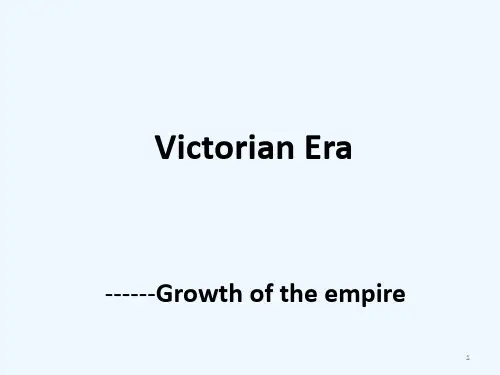
小小朱历史课维多利亚时代
维多利亚时代(Victorian era),前接乔治时代,后启爱德华时代,被认为是英国工业革命和大英帝国的峰端。
它的时限常被定义为1837年~1901年,即维多利亚女王的统治时期。
这个时期的大英帝国走向了世界之巅,它的领土达到了3600万平方公里。
大英帝国的经济占全球的70%,贸易出口更是比全世界其他国家的总和还多上几倍。
与爱德华时代一同被认为是大英帝国的黄金时代。
亦有学者认为,应将通过改革法案(Reform Act 1832)的1832年视为一个新的文化时期的开端。
维多利亚时期做情妇的女性,她们的生存与境遇是怎样的?
前接乔治王时代,后启爱德华时代,维多利亚时代后期是英国工业革命和大英帝国的峰端,与爱德华时代一同被认为是大英帝国的黄金时代。
它的时限常被定义为1837年至1901年,即维多利亚女王的统治时期。
此长时期的和平,繁荣得以更加细化.。
世界历史上的重要人物英国女王维多利亚的时代维多利亚女王(Queen Victoria)是英国历史上一位伟大而具有重要影响力的君主。
她的时代,即维多利亚时代(Victoria era),持续了整整六十三年,成为英国历史上最长的君主统治时代。
在这段时间里,维多利亚女王的领导力、决策力以及个人魅力塑造了整个英国的政治、经济和社会发展。
一、背景维多利亚女王于1819年5月24日出生在伦敦肯辛顿宫,是父亲爱德华四世的唯一女儿。
1840年,她与德国的奥古斯都亲王(Prince Albert)结婚,这段婚姻也被视为对英国历史产生深远影响的重要一环。
二、国内政治改革维多利亚女王即位时,英国正处于政治改革的关键时期。
工业革命的兴起导致了社会结构的变化和阶级矛盾的加剧。
作为君主,维多利亚女王采取了一系列政治改革措施,以维持王室的权威,并平衡社会不稳定。
首先,维多利亚女王与她的首相罗伯特·皮尔(Robert Peel)一起推动了一系列关键的政治改革法案。
其中包括《1832年改革法案》(Reform Act 1832),该法案扩大了选举人群体,使更多的人有参与政治的机会。
另一项重要的法案是《1867年改革法案》(Reform Act 1867),该法案进一步扩大了中产阶级的选举权。
此外,维多利亚女王还致力于改革英国的司法体系。
她支持建立了更加公正和高效的法院系统,并高度关注底层社会的法律保护问题。
她的努力使得英国法律体系更加完善,并为后世奠定了坚实的基础。
三、经济繁荣与帝国建设维多利亚女王时代是英国经济快速发展和帝国建设的时期。
工业革命带来了前所未有的经济繁荣,英国迅速成为世界上第一个工业化国家。
这一时期的英国在技术、贸易、军事和殖民地建设方面都取得了巨大的成就。
维多利亚女王的丈夫奥古斯都亲王在经济领域发挥了重要作用。
他主导了《1851年伦敦世界博览会》(The Great Exhibition of 1851),展示了英国工业与技术的领先地位,进一步推动了工业化进程。
Victorian Era 1837–1901--------------------------------------------------------------------------------Tudor period (1485–1603)Elizabethan era (1558–1603)Stuart period (1603–1714)Jacobean era (1603–1625)Caroline era (1625–1642)Georgian era (1714–1830)British Regency (1811–1820)Victorian era (1837–1901)Edwardian era (1901–1910)--------------------------------------------------------------------------------The Victorian era of the United Kingdom was the period of Queen V ictoria's reign from June 1837 until her death on the 22nd of January 1901.[1] The reign was a long period of prosperity for the British people, as profits gained from the overseas British Empire, as well as from industrial improvements at home, allowed an educated middle class to develop. Some scholars extend the beginning of the period—as defined by a variety of sensibilities and political games that have come to be associated with the V ictorians—back five years to the passage of the Reform Act 1832.The era was preceded by the Georgian period and succeeded by the Edwardian period. The latter half of the V ictorian era roughly coincided with the first portion of the Belle Époque era of continental Europe and the Gilded Age of the United States.The era is often characterized as a long period of peace, known as the Pax Britannica, and economic, colonial, and industrial consolidation, temporarily disrupted by the Crimean War, although Britain was at war every year during this time. Towards the end of the century, the policies of New Imperialism led to increasing colonial conflicts and eventually the Anglo-Zanzibar War and the Boer War. Domestically, the agenda was increasingly liberal with a number of shifts in the direction of gradual political reform and the widening of the voting franchise.The population of England had almost doubled from 16.8 million in 1851 to 30.5 million in 1901.[2] Ireland’s population decreased rapidly, from 8.2 million in 1841 to less than 4.5 million in 1901.[3] At the same time, around 15 million emigrants left the United Kingdom in the Victorian era and settled mostly in the United States, Canada, and Australia.[4]During the early part of the era, the House of Commons was headed by the two parties, the Whigs and the Tories. From the late 1850s onwards, the Whigs became the Liberals; the Tories became the Conservatives. These parties were led by many prominent statesmen including Lord Melbourne, Sir Robert Peel, Lord Derby, Lord Palmerston, William Ewart Gladstone, Benjamin Disraeli, and Lord Salisbury. The unsolved problems relating to Irish Home Rule played a great part in politics in the later V ictorian era, particularly in view of Gladstone's determination to achieve a political settlement. Indeed these issues would eventually lead to the Easter Rising of 1916 and the subsequent domino effect that would play a large part in the fall of the empire.The reign of Victoria is the longest in British history; it would be exceeded if the present monarch (Queen Elizabeth II) remains on the throne to 2017.CultureSee also: Victorianism, Victorian architecture, V ictorian decorative arts, and V ictorian fashion Gothic Revival architecture became increasingly significant in the period, leading to the Battle of the Styles between Gothic and Classical ideals. Charles Barry's architecture for the new Palace of Westminster, which had been badly damaged in an 1834 fire, built in the medieval style of Westminster Hall, the surviving part of the building. It constructed a narrative of cultural continuity, set in opposition to the violent disjunctions of Revolutionary France, a comparison common to the period, as expressed in Thomas Carlyle's The French Revolution: A History, Great Expectations by Charles Dickens and Charles Dickens' A Tale of Two Cities. Gothic was also supported by the critic John Ruskin, who argued that it epitomised communal and inclusive social values, as opposed to Classicism, which he considered to epitomise mechanical standardisation.The middle of the 19th century saw The Great Exhibition of 1851, the first World's Fair, and showcased the greatest innovations of the century. At its centre was the Crystal Palace, a modular glass and iron structure - the first of its kind. It was condemned by Ruskin as the very model of mechanical dehumanisation in design, but later came to be presented as the prototype of Modern architecture. The emergence of photography, which was showcased at the Great Exhibition, resulted in significant changes in Victorian art with Queen V ictoria being the first British Monarch to be photographed. John Everett Millais was influenced by photography (notably in his portrait of Ruskin) as were other Pre-Raphaelite artists. It later became associated with the Impressionistic and Social Realist techniques that would dominate the later years of the period in the work of artists such as Walter Sickert and Frank Holl.Events1832Passage of the first Reform Act.[5]1837Ascension of Queen V ictoria to the throne.[5]1840New Zealand becomes a British colony, through the Treaty of Waitangi.1840Queen Victoria marries Prince Albert of Saxe-Coburg-Saalfield. He had been naturalised and granted the British style of Royal Highness beforehand. For the next 17 years, he was known as HRH Prince Albert1840Birth of the Queen's first child The Princess V ictoria. Within months she was granted the title Princess Royal1841Birth of the Queen's heir-apparent The Prince Albert Edward, Duke of Cornwall (Duke of Rothesay). He was swiftly made Prince of Wales1842Massacre of Elphinstone's Army by the Afghans in Afghanistan results in the death or incarceration of 16,500 soldiers and civilians.[6] The Mines Act of 1842 banned women/children from working in coal, iron, lead and tin mining.[5] The Illustrated London News was first published.[7]1843Birth of The Princess Alice1844Birth of The Prince Alfred1845The Irish famine begins. Within 5 years it would become the UK's worst human disaster, with starvation and emigration reducing the population of Ireland itself by over 50%. The famine permanently changed Ireland’s and Scotland's demographics and became a rallying point for nationalist sentiment that pervaded British politics for much of the following century.1846Repeal of the Corn Laws.[5]1846Birth of The Princess Helena1848Death of around 2,000 people a week in a cholera epidemic.1848Birth of The Princess Louise1850Restoration of the Roman Catholic hierarchy in Britain.1850Birth of The Prince Arthur1851The Great Exhibition (the first World's Fair) was held at the Crystal Palace[5], with great success and international attention. The Victorian gold rush. In ten years the Australian population nearly tripled.[8]1853Birth of The Prince Leopold1854Crimean War: The United Kingdom declared war on Russia.1857The Indian Mutiny, a widespread revolt in India against the rule of the British East India Company, was sparked by sepoys (native Indian soldiers) in the Company's army. The rebellion, involving not just sepoys but many sectors of the Indian population as well, was largely quashed within a year. In response to the mutiny, the East India Company was abolished in August 1858 and India came under the direct rule of the British crown, beginning the period of the British Raj. Prince Albert was given the title The Prince Consort1857Birth of The Princess Beatrice1858The Prime Minister, Lord Palmerston, responded to the Orsini plot against French emperor Napoleon III, the bombs for which were purchased in Birmingham, by attempting to make such acts a felony, but the resulting uproar forced him to resign.1859Charles Darwin published On the Origin of Species, which led to various reactions.[5] V ictoria and Albert's first grandchild, Prince Wilhelm of Prussia, is born — he would later become William II, German Emperor1861Death of Prince Albert[5]; Queen Victoria refused to go out in public for many years, and when she did she wore a widow's bonnet instead of the crown.1863The Prince of Wales marries Princess Alexandra of Denmark at Windsor.1866An angry crowd in London, protesting against John Russell's resignation as Prime Minister, was barred from Hyde Park by the police; they tore down iron railings and trampled on flower beds. Disturbances like this convinced Derby and Disraeli of the need for further parliamentary reform. 1867The Constitution Act, 1867 passes and British North America becomes Dominion of Canada. 1875Britain purchased Egypt's shares in the Suez Canal[5] as the African nation was forced to raise money to pay off its debts.1877The Princess Alice becomes Grand Duchess of Hesse when her husband succeeds as Louis IV, Grand Duke of Hesse1878Treaty of Berlin (1878). Cyprus becomes a Crown colony. The Princess Alice dies. Princess Louise's husband The Marchioness of Lorne is appointed Governor-General of Canada1879Victoria and Albert's first great-grandchild, Princess Feodora of Saxe-Meiningen, is born.1882British troops began the occupation of Egypt by taking the Suez Canal, in order to secure the vital trade route and passage to India, and the country became a protectorate.1883Princess Louise and Lord Lorne return from Canada1884The Fabian Society was founded in London by a group of middle class intellectuals, including Quaker Edward R. Pease, Havelock Ellis, and E. Nesbit, to promote socialism.[9] Prince Leopold, Duke of Albany dies.1886Prime Minister William Ewart Gladstone and the Liberal Party tries passing the First Irish Home Rule Bill, but the bill is rejected by the House of Commons.1888The serial killer known as Jack the Ripper murdered and mutilated five (and possibly more) prostitutes on the streets of London.[5] V ictoria's eldest daughter, the Princess Royal becomes German Empress when her husband succeeds as Frederick III, German Emperor. Within months, Frederick dies, and their son becomes William II, German Emperor. The widowed V icky becomes the Dowager Empress as is known as "Empress Frederick".1870 - 1891Under the Elementary Education Act 1870, basic State Education became free for every child under the age of 10.[10]1891Victoria and Albert's last grandchild, Prince Maurice of Battenberg, is born.1892The Prince of Wales' eldest son Prince Albert Victor, Duke of Clarence dies of influenza. His place in the succession is taken by his brother Prince George of Wales (later Duke of Y ork and eventually George V).1893The Prince Alfred, Duke of Edinburgh succeeds as Duke of Saxe-Coburg and Gotha when his uncle dies. The Duchy skips over The Prince of Wales due to his renunciation of his succession rights to that Duchy.1900Alfred, Duke of Saxe-Coburg and Gotha dies. His nephew Prince Charles Edward, Duke of Albany succeeds him, because his brother Prince Arthur, Duke of Connaught and nephew Prince Arthur of Connaught had renounced their rights.1901The death of Victoria saw the end of this era, and the ascension of her eldest son, Edward, began the Edwardian era, another time of great change.EntertainmentPopular forms of entertainment varied by social class. V ictorian Britain, like the periods before it, was interested in theatre and the arts, and music, drama, and opera were widely attended. There were, however, other forms of entertainment. Gambling at cards in establishments popularly called casinos was wildly popular during the period: so much so that evangelical and reform movements specifically targeted such establishments in their efforts to stop gambling, drinking, and prostitution.Brass bands and 'The Bandstand' became popular in the V ictorian era. The band stand was a simple construction that not only created an ornamental focal point, but also served acoustic requirements whilst providing shelter from the changeable British weather. It was common to hear the sound of a brass band whilst strolling through parklands. At this time musical recording was still very much a novelty.Another form of entertainment involved 'spectacles' where paranormal events, such as hypnotism, communication with the dead (by way of mediumship or channelling), ghost conjuring and the like, were carried out to the delight of crowds and participants. Such activities were more popularat this time than in other periods of recent Western history.Natural history becomes increasingly an "amateur" activity. Particularly in Britain and the United States, this grew into specialist hobbies such as the study of birds, butterflies, seashells (malacology/conchology), beetles and wildflowers. Amateur collectors and natural history entrepreneurs played an important role in building the large natural history collections of the nineteenth and early twentieth centuries.Many people used the train services to visit the seaside, helped by the Bank Holiday Act of 1871 which created a number of fixed holidays which all sectors of society could enjoy. Large numbers travelling to quiet fishing villages such as Worthing, Brighton, Morecambe and Scarborough began turning them into major tourist centres, and people like Thomas Cook saw tourism and even overseas travel as viable businesses.An important development during the Victorian era was the improvement of communication links. Stage coaches, canals, steam ships and most notably the railways all allowed goods, raw materials and people to be moved about, rapidly facilitating trade and industry. Trains became another important factor ordering society, with "railway time" being the standard by which clocks were set throughout Britain. Steam ships such as the SS Great Britain and SS Great Western made international travel more common but also advanced trade, so that in Britain it was not just the luxury goods of earlier times that were imported into the country but essentials such as corn from the America and meat from Australia. One more important innovation in communications was the Penny Black, the first postage stamp, which standardised postage to a flat price regardless of distance sent.Even later communication methods such as cinema, telegraph, telephones, cars and aircraft, would have an impact. Photography was realized in 1839 by Louis Daguerre in France and William Fox Talbot in the UK. By 1900, hand-held cameras were available.Technology and engineeringBrunel's Clifton Suspension Bridge in BristolSimilar sanitation reforms, prompted by the Public Health Acts 1848 and 1869, were made in the crowded, dirty streets of the existing cities, and soap was the main product shown in the relatively new phenomenon of advertising. A great engineering feat in the V ictorian Era was the sewage system in London. It was designed by Joseph Bazalgette in 1858. He proposed to build 82 mi (132 km) of sewer system linked with over 1,000 mi (1,600 km) of street sewers. Many problems were encountered but the sewers were completed. After this, Bazalgette designed the Thames Embankment which housed sewers, water pipes and the London Underground. During the same period London's water supply network was expanded and improved, and a gas network for lighting and heating was introduced in the 1880s.The V ictorians were impressed by science and progress, and felt that they could improve society in the same way as they were improving technology. The model town of Saltaire was founded, along with others, as a planned environment with good sanitation and many civic, educational andrecreational facilities, although it lacked a pub, which was regarded as a focus of dissent. During the V ictorian era, science grew into the discipline it is today. In addition to the increasing professionalism of university science, many V ictorian gentlemen devoted their time to the study of natural history. This study of natural history was most powerfully advanced by Charles Darwin and his theory of evolution first published in his book On the Origin of Species in 1859. Glasgow slum in 1871Although initially developed in the early years of the 19th century, gas lighting became widespread during the V ictorian era in industry, homes, public buildings and the streets. The invention of the incandescent gas mantle in the 1890s greatly improved light output and ensured its survival as late as the 1960s. Hundreds of gasworks were constructed in cities and towns across the country. In 1882, incandescent electric lights were introduced to London streets, although it took many years before they were installed everywhere.Health and medicineAlthough nitrous oxide, or laughing gas, had been proposed as an anaesthetic as far back as 1799 by Humphry Davy, it wasn't until 1846 when an American Dentist named William Morton started using ether on his patients that anaesthetics became common in the medical profession.[11] In 1847 chloroform was introduced as an anaesthetic by James Y oung Simpson[12]. Chloroform was favored by doctors and hospital staff because it's much less flammable than ether, but critics complained that it could cause the patient to have a heart attack.[12] Chloroform gained in popularity in England and Germany after Dr. John Snow gave Queen V ictoria chloroform for the birth of her eighth child (Prince Leopold).[13] By 1920, chloroform was used in 80 to 95% of all narcoses performed in UK and German-speaking countries.[12]Anaesthetics made painless dentistry possible. At the same time the European diet grew a great deal sweeter as the use of sugar became more widespread.[14] As a result, more and more people were having teeth pulled and needed replacements. This gave rise to "Waterloo Teeth", which were real human teeth set into hand-carved chunks of ivory from hippopotamus or walrus jaws.[14][15] The teeth were obtained from executed criminals, victims of battlefields, from grave-robbers, and were even bought directly from the desperately impoverished.[14]Medicine also benefited from the introduction of antiseptics by Joseph Lister in 1867 in the form of Carbolic acid (phenol).[16] He instructed the hospital staff to wear gloves and wash their hands, instruments, and dressings with a phenol solution and, in 1869, he invented a machine that would spray carbolic acid in the operating theatre during surgery.[16]PovertyWorking class life in Victorian Wetherby, West Y orkshire19th century Britain saw a huge population increase accompanied by rapid urbanization stimulated by the Industrial Revolution. The large numbers of skilled and unskilled people looking for work kept wages down to barely subsistence level. A vailable housing was scarce and expensive, resulting in overcrowding. These problems were magnified in London, where the population grew at record rates. Large houses were turned into flats and tenements, and as landlords failed to maintain these dwellings slum housing developed. Kellow Chesney described the situation as follows: "Hideous slums, some of them acres wide, some no more than crannies of obscure misery, make up a substantial part of the metropolis... In big, once handsome houses, thirty or more people of all ages may inhabit a single room." (The V ictorian Underworld)。
课外拓展(维多利亚时期名词解释)1. English critical realism:English critical realism o f the 19th century flourished in the forties and in the early fifties. The critical realists described with much vividness and artistic skill the chief traits of the English society and criticized the capitalist system from a democratic view point. The greatest English realist of the time was Charles Dickens. With striking force and truthfulness, he pictures bourgeois civilization, showing the misery and sufferings of the common people. Another critical realist, William Makepeace Thackeray, was a no less severe exposer of contemporary society. Thackeray’s novels are mainly a satirical portrayal of the upper strata of society. Other adherents to the method of critical realism were Charlotte and Emily Bronte, and Elizabeth Gaskell. In the fifties and sixties the realistic novel as represented by Dickens and Thackeray entered a stage of decline. It found its reflection in the works of George Eliot. Though she described the life of the laboring people and criticized the privileged classes, the power of exposure became weaker in her works. She seemed to be more morally than socially minded. The English critical realists of the 19th century not only gave a satirical portrayal of the bourgeoisie and all the ruling classes, but also showed profound sympathy for the common people.2. Victorian period:It refers to the era of Queen Victoria’s reign (1837~1901). The period is sometimes dated from 1832 (the passage of the first Reform Bill), a period of intense and prolific activity in literature, especially by novelists and poets, philosophers and essayists. Dramatists of any note are few. Much of the writing was concerned with contemporary social problems: for instance, the effects of the industrial revolution, the influence of the theory of evolution, and movements of political and social reform. The following are among the most not able British writers of the period: Thomas Carlyle, Elizabeth Barrett Browning, Alfred Tennyson, Charles Darwin, W. M. Thackeray, Robert Browning, Edward Lear, Charles Dickens, Anthory Trollope, Charlotte Bronte, Emily Bronte, Anne Bronte, George Eliot, John Ruskin, Matthew Arnold, George Meredith, Dante Gabriel Rossetti, Christina Rossetti, William Morris, Samuel Butler, Swinburne, Thomas Hardy, Robert Louis Stevenson, Henry Arthur Jones, Oscar Wilde.3. Autobiography:It is an account of a person’s life by him or herself. The term appears to have been first used by Southey in 1809. In Dr. Johnson’s opinion no man was better qualified to write his life than himself, but this is debatable. Memory may be unreliable. Few can recall clear details of their early life and most are therefore dependent on other people’s impressions, of necessity equally unreliable. Moreover, everyone tends to remember what he or she wants to remember. Disagreeable facts are sometimes glossed over or repressed, truth may be distorted for the sake of convenience or harmony and the occlusions of time may obscure as much as they reveal.4. Regional novel: A regional writer is one who concentrates much attention on a particular area and uses it and the people who inhabit it as the basis forhis or her stories. Such a locale is likely to be rural or provincial. Once established, the regional novel began to interest a number of writers, and soon the regions described became smaller and more specifically defined. For example, the novels of Mrs. Gaskell (1810~1865) and George Eliot (1819~1880) centered on the Midlands, and those of the Bronte sisters were set in Yorkshire. There were also “urban”or “industrial”novels, set in a particular town or city, some of which had considerable fame in the 19th century. Notable instances are Mrs. Gaskell’s Mary Barton(1848), Charles Dickens’s Hard Times (1854) and George Eliot’s Middlemarch (1871~1872).5. Dramatic monologue:Dramatic monologue is a kind of poem in which a single fictional or historical character other than the poet speaks to a silent “audience”of one or more persons. Such poems reveal not the poet’s own thoughts but the mind of the impersonated character, whose personality is revealed unwittingly; this distinguishes a dramatic monologue from a lyric, while the implied presence of an auditor distinguishes it from a soliloquy. Major examples of this form in English are Tennyson’s “Ulysses” (1842), Browning’s “Fra Lippo Lippi”(1855), and T. S. Eliot’s “The Love Song of J. Alfred Prufrock” (1917). Some plays in which only one character speaks, in the form of a monologue or soliloquy, have also been called dramatic monologues; but to avoid confusion it is preferable to refer to these simply as monologues or as monodramas.6. Psychological novel:It is a vague term to describe that kind of fiction which is for the most part concerned with the spiritual, emotional and mental lives of the characters and with the analysis of characters rather than with the plot and the action. Many novelists during the last two hundred years have written psychological novels.7. Künstlerroman: It is a novel which has an artist (in any creative art) as the central character and which shows the development of the artist from childhood to maturity and later. In English literature the most famous example of a Künstlerroman is James Joyce’s A Portrait of the Artist as a Young Man. 8. Aestheticism: The term aesthetic has come to signify something which pertains to the criticism of the beautiful or to the theory of taste. An aesthete is one who pursues and is devoted to the “beautiful” in art, music and literature. And aestheticism is the term given to a movement, a cult, a mode of sensibility (a way of looking at and feeling about things) in the 19th century. Fundamentally, it entailed the point of view that art is self-sufficient and need serve no other purpose than its own ends. In other words, art is an end in itself and need not be (or should not be) didactic, politically committed, propagandist, moral or anything else but itself; and it should not be judged by any non-aesthetic criteria (e.g. whether or notit is useful).9. Naturalism:Naturalism is a post-Darwinian movement of the late 19th century that tried to apply the” laws” of scientific determinism to fiction. The naturalist went beyond the realist’s insistence on the objective presentation ofthe details of everyday life to insist that the materials of literature should be arranged to reflect a deterministic universe in which a person is a biological creature controlled by environment and heredity. Major writers include Crane, Dreiser, Norris, and O’Neill in America; Zola in France; and Hardy and Gissing in England. Crane’s “The Blue Hotel” (1898) is perhaps the best example in this text of a naturalistic short story.。